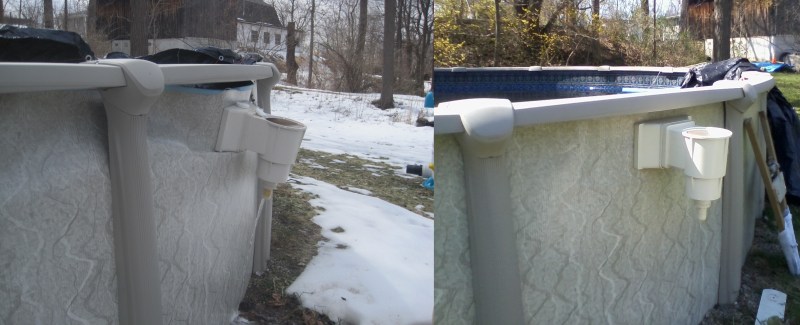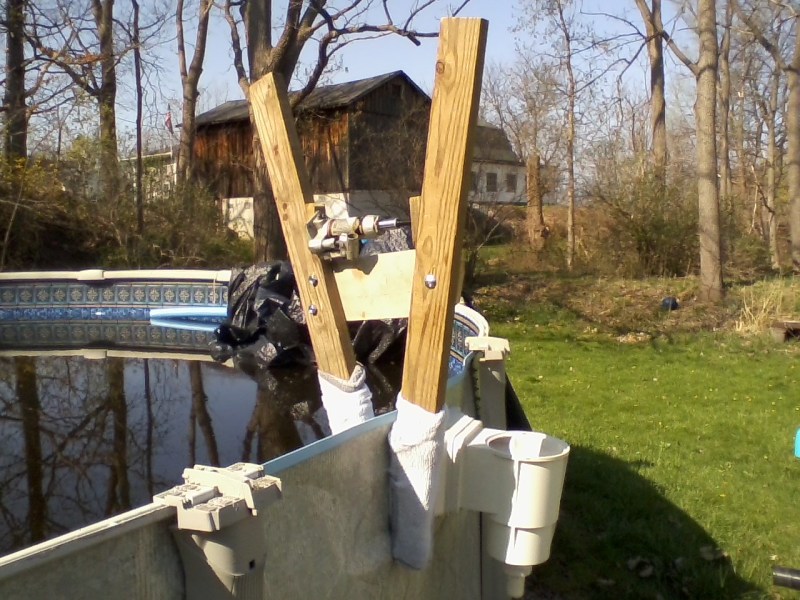[Elton] wrote in to tell us about a little excitement they had after this year’s ridiculous winter. Their pool froze and as luck would have it, crumpled the edge of the liner. They asked around and their pool company said they’d better involve their insurance company because it would not be easy to repair — so they decided to try fixing it themselves.
Now since the pool liner is a fairly heavy gauge sheet metal, they wouldn’t be able to simply hammer it back into shape — so they started brainstorming ways to make their very own hydraulic clamp. What they came up with is a very clever application of physics. And all it cost was about $2 in hardware plus some scrap lumber and a bottle jack they had lying around.
Some of their first ideas included a scissor style clamp, and even a monkey wrench-like vice, but in the end, the following design was chosen — and worked.
Ideally the hydraulic jack would be farther from the fulcrum, but since it’s rated for 2 tons it ended up being more than strong enough. To avoid scratching the liner, they also threw some socks on the end of the lumber. Still rather unwieldy, it was a two person job to pop it out. But once they got the major dents out, they were able to use a rubber mallet to finish the job off. Hooray for fluid power!
If you’re looking for the link, there isn’t one. [Elton] sent us his pictures and told us the story directly.

















I don’t understand the repair, (altough the jack is very cool).
The metal edge of the pool was warped by pressure from the ice. They straightened out the metal using a DIY hydraulic vice to the point they could finish smoothing out the warping with a rubber mallet. (I doubt beating the warping out with a rubber mallet straigh away would have been much slower but whatever. Kuddos for taking out a lot of the hard work)
The top pic is actually two different pictures, the first on the left shows a small dent. The second on the right shows the fixed product after it was bent back into place with this DIY hydraulic clothespin. I didn’t understand what was going I when I first saw the pic and read the description. I thought the top pic was one inage of a pool shorn in half, lol.
As for this hack, I do like the ingenuity of it, as well as the easily accessible components. I don’t have a pool, but I’m sure I could find a use for this at some point
“I when I first saw the pic and read the description. I thought the top pic was one inage of a pool shorn in half, lol.”
I thought the exact same thing. But in the end this hack is just a big dent fixer, nice idea
Next time, fill the pool with anti-freeze instead of water.
Nope, just a bubbler. Honestly I am surprised they did not have one as that is a common item in above ground pools in freeze prone areas.
Or salt.
The problem with using anti-freeze or salt is that when summer comes around, you’ll have to drain completely the treated water and then completely fill the pool with fresh water (100,000 liters or more). Depending on what’s in the water, you might have a problem finding a safe place to drain all that treated water, plus water can be expensive depending on the area. Either you fill the pool with your garden hose (which is very slow) or you call a water tanker (which is fast), both can be somewhat expensive
No, salt-water pools are becoming more common! The simple reason is chlorine: Salt (NaCl) dissociates in water. Remove Na+ ions (via a set of reactions that start with the electrolysis of water), and you get all the nice Cl- ions you need to discourage bacterial, fungal and vegetative growth.
But winter will require a much higher salt concentration than a “salt water pool” normally requires. The solution is to let the pool evaporate during the fall (which concentrates the salt), then add more salt during the first freeze (on top the ice). And be sure to toss in an inner tube to absorb the inevitable ice formation during a bad cold snap.
In the spring, bring up the water level and start electrolysis until the chlorine level is good. Then check the salt concentration, and do a single partial-drain and refill to restore the desired salt level.
In my experience, the salt level usually landed well within range after the chlorine level was restored, and I’ve never had to do a partial drain and refill operation to reduce it. The reason, I suspect, is because all the chlorine goes away druing the fall and winter, and lots has to be made sodium (well, lots of sodium has to be removed), which takes care of most of the excess salt.
I’m kind of partial to filling it with air although that does require a cover to keep the water out.
With longer lever arms on the top (use 8′ lumber, a pivot with holes at several distances and a ladder), you wouldn’t need the bottle jack at all which would be faster and easier to use, plus you’d get bragging rights over the biggest pair of slip-joint pliers in the neighborhood.
Many independtlt figure out a bottle jack use horizontally can be useful IF you can position it with the pump onn the bottom or in position it still in the fluid. On heavy duty jobs jacks with cast iron bases can bust the base out if it isn’t supported in some manner. As far as the insurance company goes they might say sorry Charlie you should have drained it, they don’t cover negligence. as the drought continues pool owners might have to put in an under ground storage stank to store the water in over ttthe Winter, or put a building over it, so they could use it year round
creating your own tools to fix something, now this is a hack i like.
So was winter a surprise to them? Didn’t they know it gets below freezing? Was this the first winter they had the pool? Did they move to the area from Florida? Seems really stupid not to prep the pool for a known risk (i.e. water freezes in the cold). Winterizing the pool is a standard task for all Northern pool owners, and the “close date” is burned into all kids and neighbors mind as they whine for just one more week.
I guess you’re not from the North? It was the coldest recorded winter in many US states (and of course Canada). So no, not many people were prepared for it!
Taught at NMU for a few years, never once woke up in January and looked out the window and said “Wow, a meter plus of snow, how did that happen”.
I would love to sell you insurance, as it seems that you never ever ever makes mistakes or overseen something that ended in a mishap. Ever. You should run for president of your Country. Or the Catican: impeccable.
There were days this winter where it was colder in Atlanta than in Anchorage. A lot of places froze that hadn’t frozen in years, decades, or longer. Even parts that usually freeze in winter had cold temperatures coming earlier than usual, sometimes bookended by abnormally warm days.
True, but you don’t freeze solid 30,000 liters (or more) because of a cold snap. I guess it all depends on where this mishap happened.
It would have only frozen the surface, not the entire volume of the pool.
We had an above ground pool when I was a kid. Every year it would freeze solidly enough for ice skating, without damage. I don’t remember much about the construction, but I recall it having some supporting structure that this one doesn’t seem to have.
I doubt any supporting structure would withstand the force of ice forming, its pretty powerfull. perhaps your pool had vertical “folds” so the pool could expand a tiny bit, like a corrugated roof.
I live in a place where it does not freeze in the winter, so I don’t have a lot of experience with damage caused by freezing, but to me that looks like force was applied to the outside top of the skimmer to get that kind of damage.
Please correct me if I am mistaken.
You are mistaken. ;)
Water expands when it freezes, and here it pushed against the pool, buckling it. You can probably guess how thick the ice was from where the metal was deformed.
Yes that is exactly what I don’t see. The metal goes inward from the sides of the skimmer, the V of a point load not the curve of a distributed load. I also do not see a line on the inward buckle where the thickness of the ice kept it from folding it looks like a pretty smooth curve all the way to the top.
It almost looks like downward force was applied to that white plastic thing sticking out the side. The walls of the pool have actually pulled in at the closest support, which doesn’t sound like something ice expansion would lead to.
I live in Sydney, Australia though. The closest thing we get to freezing is a light frost.
Only takes a couple hundred Kay’s down south to experience the freeze tho ;)
One thing I might do is make a stand for the drain in that bent section so it doesn’t put as much strain on the side when the snow piles up on it.
I don’t see any cauls or blocking to flatten the bends, just the square ends of the 2 by 4’s. The pads should be thin and let the force of the flats do the work.
This must not have been frozen to the bottom, or there would have been ruptures at the bottom seam. You are lucky.
It was below -4F here this winter, so I imagine my above ground pool froze pretty solid this year too. I put air pillows in the pool when I winterize it though. So I am not anticipating any major damage when I uncover it. But who knows? I have not seen it yet. That pool water looks pretty murky brown to me. How do they ever manage to clean it up? Covered my pool stays crystal clear throughout the off season.
Now this is a hack, take a bunch of parts, toss’em together and fix a problem that would seem to have absolutely nothing to do with the parts you threw together. Oh and maybe its just me but did anyone else but me think they should have just drained the f**king pool? (I don’t own a pool by the way but am always looking for invites during the summer.)
By the look of the water it has to be drained anyhow, so, why not drain it in fall?
A little more to the story can be found here:
http://www.troublefreepool.com/threads/92217-Ice-Damage-Repairs